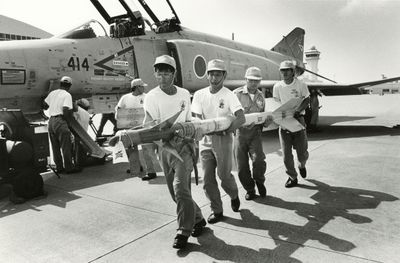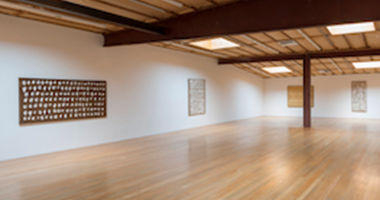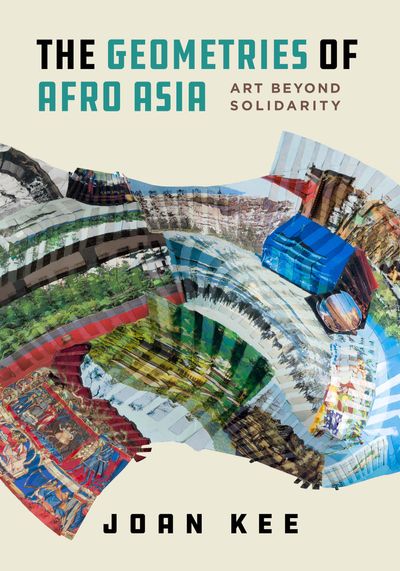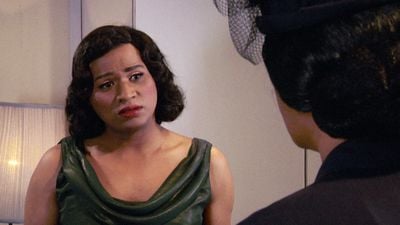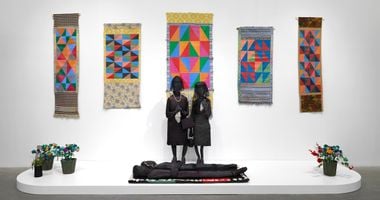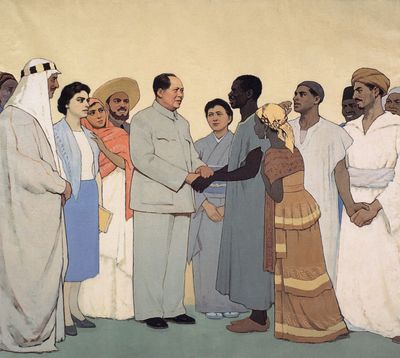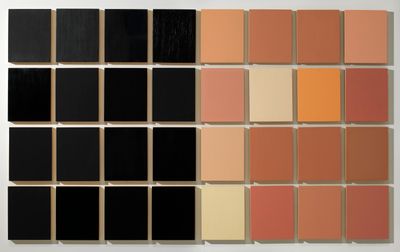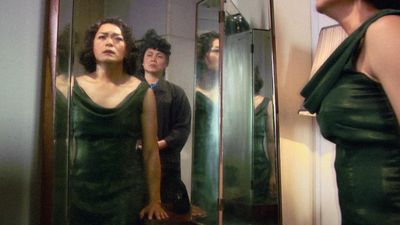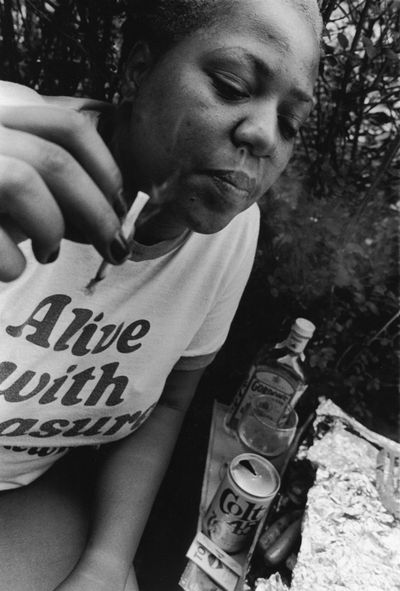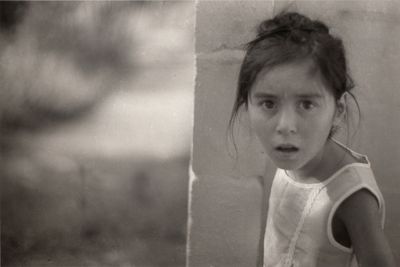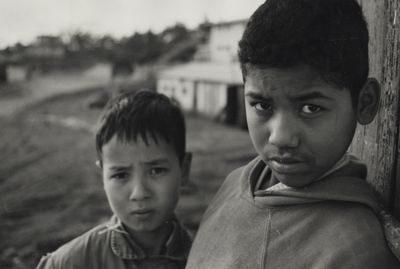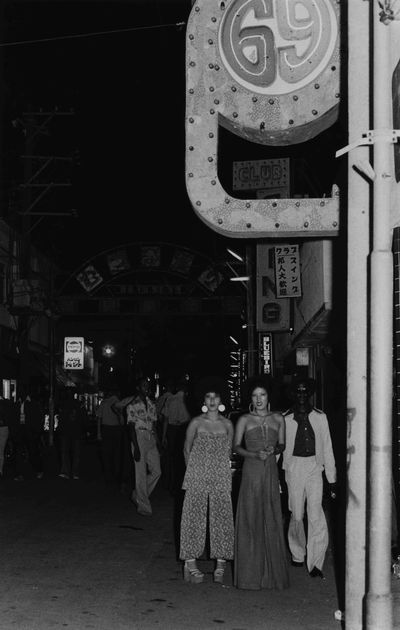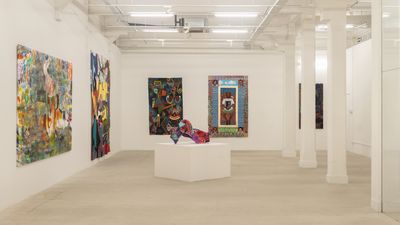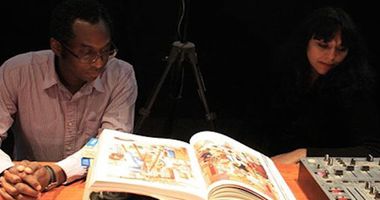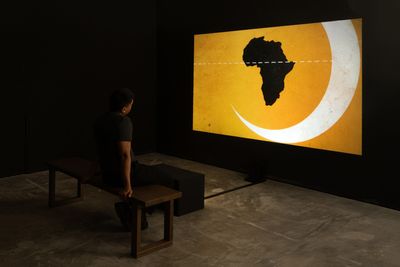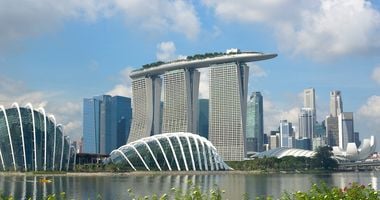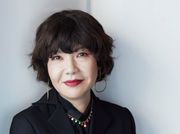Joan Kee on the Geometries of Afro Asia
Joan Kee. Courtesy Joan Kee.
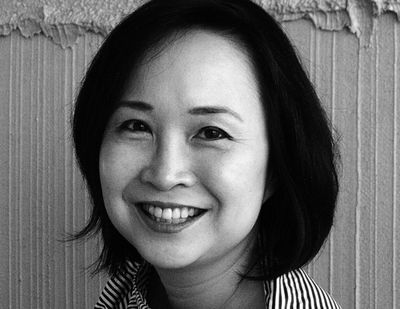
Joan Kee. Courtesy Joan Kee.
Joan Kee's most recent book explores the understudied relationship between Black and Asian artists, proposing alternative ways of thinking about an artwork.
Kee is a professor in the History of Art at the University of Michigan, and The Geometries of Afro Asia: Art beyond Solidarity (2023) is her third sole-authored book. It was recently cited as influencing curator Zoé Whitley's thinking around Translations: Afro-Asian Poetics, an expansive exhibition which opened in Singapore this month. Kee's first book, Contemporary Korean Art: Tansaekhwa and the Urgency of Method (2013), was pivotal in launching global interest in the titular art movement, while her second book, Models of Integrity: Art and Law in Post-Sixties America (2019), drew rave reviews from both the art world and the legal profession.
Querying what a history of art built around the 'global majority' might look like, The Geometries of Afro Asia examines the work of select Black and Asian artists—for example, Howardena Pindell, Mao Ishikawa, Ming Wong, Byron Kim, and Glenn Ligon. Kee also considers how connections between artists intersect with different cultural and historical contexts, including South Korea during U.S. military occupation in the 1960s and 1970s and globalisation in the 1990s and 2010s.
In this interview, Kee discusses The Geometries of Afro Asia, touching on why she began exploring connections between artists. She cites artworks as sources of possibility and encourages audiences to consider alternative ways an artwork might have come about, what its 'companions' might be, and what relationships it might draw upon.
ADThe genesis of your latest book was some 25 years ago, prompted by a class you took on African American art in 1995.
JKYes, I took a course on African American art taught at Yale University by Judith Wilson, the critic and scholar whose writings on gender and race played a formative role in my own thinking. In many ways, the book is an homage to her instruction. But I didn't feel I could write it until now, partly because I wasn't sure it could find a home! I confess to having a bit of PTSD after having my book on a well-known Korean artistic movement turned down by nine U.S. academic presses.
The recent proliferation of exhibitions, books, talks, and other interventions focused on Black and African diasporic art helped create a space where discussing Afro Asian connections became more possible.
ADI understand it was in Judith Wilson's class that you first saw the artwork by Howardena Pindell, Autobiography: East/West (Gardens)(1983), which features on the book's cover.
JKYes. That work is seldom given pride of place in books or exhibitions dedicated to the artist. Rarely do Pindell's works relevant to her time in Japan or India receive sustained attention, which to me reads as a gross underestimation of her deep cosmopolitanism. Autobiography: East/West (Gardens) (1983) elegantly cuts across linear histories of art, separated by geography and chronology, and lays bare the inadequacy of terms like 'influence'.
Pindell had a challenging time in Japan, experiencing many instances of racial and gender discrimination. But it was also a generative experience for her, especially after she saw the Heike Nōkyō, the elaborate late Heian-era scrolls at Itsukushima Shrine, a short distance from Hiroshima. When I saw Autobiography: East/West (Gardens), I kept thinking of how Heian poets regarded citation as a highly visible exercise of personal agency rather than an act of deference to precedent.
Afro Asia sparks consideration for other global majorities that complicate how we approach the question of 'we'.
Pindell's reference to what histories of modern and contemporary art would call 'premodern' Asian art reminds us of the long history of Asian and Black intersections. A case in point is Madagascar's population—largely descended from the Banjar people, who migrated from present-day Borneo to East Africa well before Europeans set foot on African soil. These intersections aren't as well-known as they should be.
What might an art history that is more receptive to the roughly three-quarters of the world's population who call Africa or Asia home or who identify as Asian and/or Black look like? This is one question I ask in the book. But I also want to avoid treating race, ethnicity, or national and regional origins as vacuum-packed readymades. Afro Asia sparks consideration for other global majorities that complicate how we approach the question of 'we'. An example is the concept of 'the 99 per cent', deployed with great impact during the international Occupy movement between 2011 and 2016.
ADYou wrote a paper in 1995 on the presence of Asian art in Black American art, focusing on Pindell, and also Camille Billops and Raymond Saunders. You saw Pindell's work for the first time that year in the exhibition Ancestors at Kenkeleba House in New York City. Can you discuss this show?
JKKenkeleba House partnered with the Asian American Arts Centre (AAAC) to present Ancestors. The show was quite pivotal for me. The Kenkeleba House and AAAC have both always had a vigorous multicultural programme. Corrine Jennings ran Kenkeleba House, and Bob (Robert) Lee ran AAAC, but, according to Bob, neither felt limited by their racial identities, and together they bought a group of artists together for Ancestors.
Many well-known names took part, including Simone Leigh and Faith Ringgold. These are artists who have engaged seriously in thinking about shared identities. Ancestors also echoed a commitment to a retooled conception of a 'Third World' that had gained momentum in the U.S., mostly in San Francisco, L.A., and New York in the 1970s and 1980s through artists like Carlos Villa. Artists were thinking about what they had in common. It wasn't that the debates we have now about cultural appropriation didn't exist, but artists were more interested in how to build a world in common—one that is not obsessed with finding every division or past slight or harm but instead asks about connections made, reaffirmed, imagined, and interrupted.
After I wrote that paper, I started keeping tabs on artworks by Black American artists that demonstrated serious engagement with Asian artistic practices. Over the years, the list has grown to about 100 names; that is probably just the tip of the iceberg. It's even longer when accounting for artists based in Africa or for Asian artists committed to thinking about the worlds that African art encompasses. Almost every week, I get reader emails added to this list! And every work dispels the idea of a canon or that a preselected group gets to represent a designated whole.
ADWhy the title, The Geometries of Afro Asia?
JKDecolonisation movements throughout Africa, Latin America, and Asia in the 1950s and 1960s were based on questions around nationalism and related strongly to the idea of racialised bodies. No doubt those questions matter, but if they become the dominant questions, they tend to reduce cultural production to by-products of large-scale political and economic processes.
Initially, I thought of calling the book 'Afro Asian Bodies', but that didn't get at the nature of connection, which in many ways is much more important than the connection itself. Geometry involves visualising connections in space. It offers many useful terms for specifying how art cuts across different histories from unexpected perspectives.
Geometry also gets you thinking about how things are shaped, moulded, inverted, or even deformed when they come into contact. That's important if we want to unsubscribe from the idea of art as a passive object, at the mercy of outside whims and actions. A work like Pindell's puts us through our paces—it makes us jump around from one time and place to another.
ADIn the book's introduction, you discuss a painting by Wu Biduan and Jin Shangyi: Chairman Mao Standing with People of Asia, Africa and Latin America (1961). Why begin with this painting?
JKThis work—one of the truly under-recognised paintings of the mid-20th century—is much more than an assembly of national delegates. The Japanese delegate stands at the centre, which you might think strange given that China and Japan were not exactly the best of friends. However, it was painted right after China agreed to resume trade relations with Japan. It is also very telling that the Japanese delegate is distinctly portrayed as a supplicant in relation to Mao. In portraying a world that appears to revolve around Mao, the work blatantly rejects both U.S. and Soviet worldviews.
Opening the book with this work also stemmed from a desire to challenge a certain kind of U.S. exceptionalism underwriting numerous art histories. In art history, this exceptionalism is closely tied to concepts like the 'global contemporary'. Calls for specialists in 'global contemporary art'—shorthand for non-Western art—are common in the Anglophone academy. You can offload so much into this basket without ever having to think about the difficulty artworks pose.
ADYou use the term 'global majority' in the book.
JKIf we must use 'global', why not bring back 'global majority'? It is a deliberately imprecise term that predates recent discussions of globalisation and is entwined with a rich variety of thinking, from pro-worker discussions of Latin American economies to independence movements in Africa in the 1960s. I prefer it to 'Global South' or POC [People of Colour] as the 'global majority' is more of an arguable proposition. We can't take its meaning for granted. In this context, the Asian African Conference of 1955—commonly known as the Bandung Conference—is worth revisiting. The Conference brought newly independent African and Asian countries together for the first time, involving leaders like Sukarno of Indonesia, Nasser of Egypt, and Nehru of India. But its goals of lasting political and economic cooperation outside Cold War agendas failed for many reasons, one of which was acute ethnonationalism.
The Afro Asia that I think has the most political possibility is that which takes shape around underground, low-key, unofficial, and frequently transient encounters.
Wu and Jin's painting is a great angle on the Bandung Conference and the idea of a 'global majority'. It also shows the importance of ink painting and Socialist Realism to any history of art that takes the global majority seriously. It's not an ink painting, but it couldn't have been made without knowledge of the histories and conventions of ink painting. A global majority art history means pooling ideas together rather than keeping them apart.
At the same time, I'm not calling for a resurrection of the so-called 'Bandung spirit'. Nation-states have a terrible way of repeatedly letting their citizens and residents down. Likewise, regionalism has a way of devolving into crude bloc factionalism. The Afro Asia that I think has the most political possibility is that which takes shape around underground, low-key, unofficial, and frequently transient encounters. Nation-states, regions, and racial categories are not the basic units of operation. Spending time with Wu and Jin's painting made that clear to me, even if at first it looks like a portrait of symbolic national representation.
Many configurations of a global majority involve mostly Asian and Black bodies. Thinking about Black and Asian artists together in the same show is still not, to my knowledge, very common, which I find odd. Why aren't there more such pairings?
ADYet the book's subtitle, Art beyond Solidarity, seems to contradict this idea of looking for connections.
JKActually, I wanted to call it 'Art Against Solidarity' to more forcefully emphasise how artworks refuse political consolidation, no matter how well-intentioned. Works that are in some way illegible or uncomfortable—or which present a moment that can be disagreed over—nurture different connections other than unity or solidarity. Hence, Art beyond Solidarity.
Consider the collaborative work by Glenn Ligon and Byron Kim. Both artists are sceptical of the terms we take for granted when we see flesh-toned colour or the word 'black'. We sometimes think black is just some kind of uniform and unchanging idea, when in fact, in the work that Ligon and Kim did together, you see that the blacks take on very different nuances. Black becomes Blackness that works as a shape-shifting membrane.
I don't think solidarity should be a final goal; it's kind of a step towards something else. This book is partly a call to do better than what solidarity asks. It's not just about unity or coalition; I'm interested in things like companionship or friendship, sympathy, and disagreement, and collaborative works are a great way of thinking through these.
ADYou also discuss Ming Wong's two-channel installation, Life of Imitation (2009), in relation to the idea of multiculturalism.
JKI saw Wong's video installation at the 2009 Venice Biennale, where he represented Singapore. I was completely blown away. For me, that was the standout work of the Biennale. The work really troubled me—in a good way—for a very long time. It got me thinking about how everything that is commonly assumed about multiculturalism is so woefully incomplete.
I like to think of artworks almost as if they were countries: they monitor their own boundaries, set their own rules, [and] establish interdependent relationships with other artworks.
Wong's installation draws from a scene from the classic Hollywood melodrama by Douglas Sirk, Imitation of Life (1959), where a Black mother meets her mixed-race daughter who has been passing herself as white. The daughter rejects her Black identity and her mother, who in Sirk's film is a domestic worker.
In Wong's version, three male actors from the three main ethnic groups in Singapore (Chinese, Malay, and Indian) take turns to play the Black mother and her 'white' daughter. The identity of the actor for each role changes with each shot. And that forces a very different debate about race, one that doesn't begin and end with white and Black antagonism. I think what Wong says is racial dramas play out very differently in other parts of the world. Afro Asia is a call to recognise those other stories.
ADIn the chapter 'Angles of Incidence', you look at the impact the U.S. military occupation in Japan and South Korea had on the photographic practices of artists like Joo Myung Duck, Shomei Tomatsu, and Mao Ishikawa.
JKThe rapid expansion of photography in postwar Asia stemmed partly from orientations towards new encounters due to the occupation, including those between Black military and Asian civilian populations. I wanted to think about photography through that lens, mainly because photography that looks at this very difficult time tends to either be about valorising the multiracial figures we see, or about oppression and trauma. I felt that such narratives failed to consider what was happening in each photograph.
ADYou relate Joo, Tomatsu, and Ishikawa's photographs of Afro Asian encounters to an idea of 'decomposition'. Can you discuss this?
JKOften, figures in these artists' images aren't clear. They are blurred, and not just aesthetically. It's as if the longer you look, the more the image falls apart, and you become unsure about how to relate to this image.
Joo Myung Duck, for example, photographed biracial children, particularly children whose parents were Korean and Black. But he didn't want to racially stereotype his collaborators—that was a word that he himself used, which I found interesting. He didn't think of them as subjects. The word 'subject' can come across as negative. Joo wanted the children he photographed to push back or deny the camera's presence. That's why you see so many faces turned away and to the side in his book.
ADAs a viewer, it's hard to know how to commit to these images. I am not sure I see these children as collaborators.
JKYour doubt is useful in thinking about how photographs become sites of uncertainty when we start to feel a little unnerved about what we're looking at or not seeing. We see a child photographed by an adult. What is this relationship about? And what does that make us, as viewers?
Joo took his photographs in authoritarian Korea, where the notion of consent was so suppressed as to be non-existent. Photographing the children in this way that has us thinking about childhood agency was a distinctly political act on Joo's part. At the same time, the photographs don't insist on a single political statement. Each image is its own realm with its own visual priorities.
One of the most important things Afro Asia does is demand reconfiguration according to place, outside of existing political regionalism or territorial claims.
When speaking about artworks, I use the word 'sovereignty' rather than 'autonomy'. Autonomy is central to a particular kind of modernist art history—i.e. that is to say, art can be indifferent to the world around it, and so on. But I don't think it's indifference. Artworks can seem uncompliant, unyielding, and even downright antagonistic. We who demand an explanation about what artworks 'mean' are like hostile invaders approaching inhabited land to conquer. I like to think of artworks almost as if they were countries: they monitor their own boundaries, set their own rules, and, most importantly, establish interdependent relationships with other artworks. Rather than try to ignore or explain the difficulty artworks pose, our responsibility as viewers is to accept that artworks have their own internal conflicts and dynamics.
ADIn relation to sovereignty, you discuss Mao Ishikawa, who moved back to Okinawa from Tokyo in 1975 and worked as a hostess in bars and clubs catering exclusively to Black servicemen in Koza and in the town of Kin near the Marine Corps base Camp Hansen.
In the book, you note how her photographs also give themselves over to her subjects far more than many of her contemporaries.
JKImages of U.S. soldiers taken by Korean and Japanese photographers were common during the occupation. But what struck me about Ishikawa's work was an uninhibitedness—it empowered women in positions of uncertainty, who existed in a deeply patriarchal world and were frequently subjected to mental and physical violence.
One of the most visually arresting images is of Ishikawa's friend in her home. She swivels her body and head around to stare and smile at the camera. She's striking this elaborate pose, and a big Bruce Lee poster is in the background. There is something divine about it, in both a colloquial and religious sense.
ADDo you mean in a 'Madonna' sense?
JKYes, exactly. At first glance you wonder, is she mimicking a pin-up? But Ishikawa has cropped the image so that her body takes up all the space. It's also a space we are not allowed to enter—something about it says to keep your distance and admire her from afar. She is not for sale, and she's not something that you can touch or possess.
Ishikawa's photographs almost function as a refusal of possession. You can go to a bar and you can hang out with these women for the price of a few drinks, but they can never be owned. Rather, they own their own space. In the book, I include a photograph of one of Ishikawa's friends, looking as though she is holding court with her gentlemen suitors surrounding her. It almost struck me as a royal portrait.
ADA show opening ahead of Singapore Art Week at The Institutum, Translations: Afro-Asian Poetics, will feature 100 artists from Africa, Asia, and their diasporas. The curator, Zoé Whitley, cites your book as an influence. Can you discuss this exhibition and what new threads or angles it opened for you?
JKThankful as I am for the generous interest in my work, I was not involved at all with the selection, display, or contextualisation of works in this show—it is entirely the brainchild of Zoé and Andreas Teoh [founder of the Asian Art Institutum, Singapore]. That said, The Otolith Group, whose work appears in the show, has been extremely productive for my thinking. They will soon debut a work focused on the Afro-Asian Women's Conference, which took place in Colombo in 1958. It is an important project, particularly given how most of the attention on Afro Asian political internationalism revolves around what men have to say. Women-led conferences rightly observed that postcolonial liberation could only truly be realised in tandem with the emancipation of women. How this takes shape through The Otolith Group's visual and sonic forms will be exciting to see.
Singapore offers an interesting angle through which to consider Afro Asia. It throws into relief histories of trade, migration, and dispersal across the Indian Ocean that have occurred over centuries, as well as models of Blackness outside the Black Atlantic model. At the same time, it's important to remember that neighbourhoods, informal gatherings, and non-governmental assemblies are the primary units of social organisation for Afro Asia, not cities.
One of the most important things Afro Asia does is demand reconfiguration according to place, outside of existing political regionalism or territorial claims. Above all, it is important to ask: how does Afro Asia encourage us to think with artworks that fold us into communities or situations we might initially think detached from our own lives? —[O]



